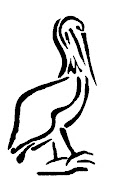I know it's been a while since I posted (like 7 years! Yikes!) but in the interval I started a marine service business, made lots of friends and hardly ever took Pelican out.
That's about to change.
There's a new adventure afoot and it's causing me to work on Pelican on projects that have been piling up for the last years as I worked on everyone else's boat.
One was replacing the port water tank that leaked since I purchased Pelican and caused me to only use the bow and starboard tanks for a mere 110 gallons of water. Now I'm back to the full 160 gallons.
 First, I had to uncover the old tank - the leak was somewhere near the bottom so there was still a few gallons of water in it. With the cover plate removed water was out in short order with a wet-vac.
First, I had to uncover the old tank - the leak was somewhere near the bottom so there was still a few gallons of water in it. With the cover plate removed water was out in short order with a wet-vac.That was the easy part.
Next I had to cut the tank out. That was the hard part. Also messy. When I say messy I really mean disasterous. First with the top open I could see the construction and figure out where the main cuts could go. Interestingly, if I do the starboard tank I know that all I have to cut is the tabbing but that I figured out too late here.
Also, I figured out that not all vacuums are the same. I was using the Home Depot vacuum that fits on a 5 gallon pail to catch the dust except for this: the filter does not catch fiberglass dust. As I was cutting I looked over to see it blowing the stuff out the back into the v-berth. That was annoying.
Cutting fiberglass is always difficult but there's a great blade from Rigid - it's a metal cut 4.5" cutoff blade with diamond edges. It's amazing and makes quick work of it. It also makes a terrific mess.

All in all, it took about 3 hours to remove the tank in pieces.
Then it took another three or four hours to clean the boat. It's amazing how much dust I made.
 It should be noted that I wore a professional mask while working with the fiberglass. Highly recommended. In fact, do not work without one.
It should be noted that I wore a professional mask while working with the fiberglass. Highly recommended. In fact, do not work without one.Finally I laid the bladder tank in the void. It fits beautifully. It's a 200L (52 gal.) tank from Plastimo. It differs from others in that the interior bladder is replaceable - the outer cover is where the strength comes from.
 As an aside, it turns out their life rafts are built the same way - replaceable bladders in cordura bags.
As an aside, it turns out their life rafts are built the same way - replaceable bladders in cordura bags.Finally, all hooked up and filled. One of the nice things about the bladder is that there's no vent. It's not needed.
I'm really happy - let's see how it lasts. I have a spare, just in case. Both of them together were less expensive than one of Vetus' tanks. So there's that.
Another project I've wanted to do since I purchased Pelican was to redirect the deck drains directly out the hull instead of below the waterline with no seacocks. A stupid and dangerous design especially since two of the hoses had never been replaced (since 1978) because they were hard to get at.
At haul out (future post) the through hulls will be removed and glassed over.
My life raft has been recertified by the lovely people at LRSE in Tiverton RI. They let me watch it being inflated (from an air system, not the cylinder. That's because you only get three cylinder inflations before you have to replace the raft).
Here's the raft unpacked from the case and unfolded.
This is the raft inflated until the relief valves lift (how you know it's completely inflated to the proper pressure).
Finally, this is removing all the equipment for inspection and replacement where required.
The last project tackled here at the marina was to redirect the deck drains out the side of the hull. In my effort to minimize holes in the boat below the waterline I decided to remove the deck drains - they are 1.5" just below or at the waterline and did not have seacocks. Worse, two of them still had original hoses on them because they're too hard to access. So, nearly 40 year old hoses.
They had to go. I have no pictures but let's say two were easy, one was harder, and the last was nearly impossible. But job done and at haulout, holes will be plugged.
Well, that's about it for now. In another day or so Pelican is off to be hauled out and work finished for the major projects.





